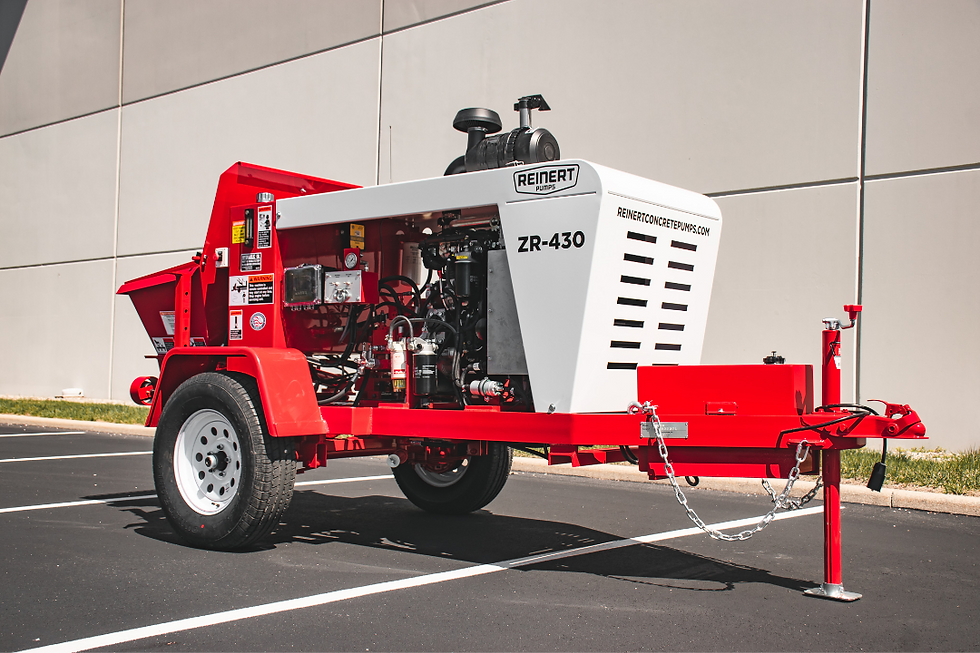What is Concrete Pumping? An In-Depth Exploration
- Shelley Fardo
- Mar 17, 2024
- 3 min read
Updated: Mar 24, 2024
Concrete pumping stands as a cornerstone in modern construction, transforming how concrete is delivered and placed across an array of projects. This method is not just about moving concrete from point A to B; it's about doing so with unparalleled efficiency, precision, and flexibility. The use of concrete pumps enables the construction of monumental skyscrapers, complex residential foundations, and diverse infrastructural projects with ease and reliability. This guide ventures into the origins, mechanisms, advancements, and the profound influence of concrete pumping on construction methodologies. It highlights the pioneering innovations by industry leaders such as Reinert, showcasing how these advancements have propelled the construction industry forward.

The Evolution of Concrete Pumping
Concrete pumping introduced a paradigm shift from the labor-intensive, manual techniques of yesteryear to today's automated, mechanized processes. This transition has not only enhanced operational efficiency but also expanded the realm of possible construction projects. Innovations like the Reinert Hinge Valve assembly are emblematic of the industry's dedication to improving maintenance efficiency and operational reliability. Such technological advancements have made feasible projects that were once considered beyond reach, thus expanding the frontiers of construction capabilities. Below, Jerry Reinert, founder of Reinert Manufacturing, can be seen displaying one of the very first pumps designed and built by our company.
Mechanisms of Concrete Pumps
To fully appreciate the impact of concrete pumping technology on construction, one must understand the intricacies of concrete pump mechanisms:
Mechanically Controlled Systems: These systems operate independently of electrical power, offering unparalleled reliability and reduced susceptibility to electrical malfunctions. They are especially valued in challenging construction environments.
The Hopper: This is where the concrete mix begins its journey, designed to prevent blockages while facilitating easy loading and cleaning. Innovations in hopper design, such as those implemented in Reinert pumps, aim to minimize material buildup and simplify the cleaning process.
Cycle Yards per Hour (cyph): This efficiency metric is critical for selecting a pump that matches the project's scale and pace, indicating how much concrete can be delivered within an hour.
Hydraulic Systems: These systems are the pump's powerhouse, driving the pistons that propel concrete through the pipeline. The adoption of single-circuit hydraulic systems in Reinert pumps highlights the focus on reliability and uninterrupted operation.
The Delivery Line: Essential for directing concrete flow to the precise location needed. Its layout significantly impacts the efficiency of concrete placement, especially on complex construction sites.

Comprehensive Guide to Selecting the Right Concrete Pump
Selecting the appropriate concrete pump involves a thorough consideration of several factors:
Project Scope and Requirements: The scale, volume, and specific demands of your project determine the most suitable pump type.
Pump Type and Capacity: Whether choosing between boom pumps, line pumps, or stationary pumps, the project's requirements should guide this decision, alongside the pump's capacity to meet job needs.
Innovative Features: Operational efficiency and maintenance ease, such as provided by the Reinert Hinge Valve, are critical considerations impacting the pump's performance and longevity.
Quality and Durability: Opting for pumps from reputable manufacturers ensures reliability and performance across the project's lifespan.
Service and Support: Access to spare parts and reliable customer service is crucial for minimizing downtime and sustaining productivity.
Cost Efficiency: Balancing initial purchase costs against long-term operational expenses is key, with renting as a viable option for short-term or singular projects.
Environmental Considerations: Eco-friendly features, like improved fuel efficiency and reduced emissions, are increasingly important for projects focused on minimizing environmental impact.

Expanding the Applications of Concrete Pumping in Construction
Concrete pumping's adaptability renders it suitable for a broad spectrum of construction tasks, each with distinct requirements:
Landscaping and Pool Construction: Its value extends beyond large projects, proving indispensable for precise concrete placement in intricate designs or confined spaces.
Foundation Slabs and Subfloors: Efficient concrete pumping is vital for laying a solid foundation, setting the stage for subsequent construction phases.
Power Plants and Energy Facilities: These projects often necessitate the precise placement of large concrete volumes, underscoring the necessity of concrete pumping for such critical undertakings.
The Reinert Advantage: Emphasizing American-Made Quality
Reinert's dedication to American-made quality and innovation has solidified its status as a concrete pumping industry leader. With a broad range of pumps tailored to meet diverse construction needs, Reinert ensures every project has access to equipment that meets its unique requirements, highlighting versatility, reliability, and customer-centric solutions.
Looking Forward: The Future of Concrete Pumping
The future landscape of concrete pumping is marked by ongoing innovation, with a focus on enhancing efficiency, sustainability, and safety. Reinert continues to lead these advancements, refining their product offerings to align with the industry's evolving demands, ensuring that concrete pumping remains a pivotal tool in the construction sector's arsenal.



Comments